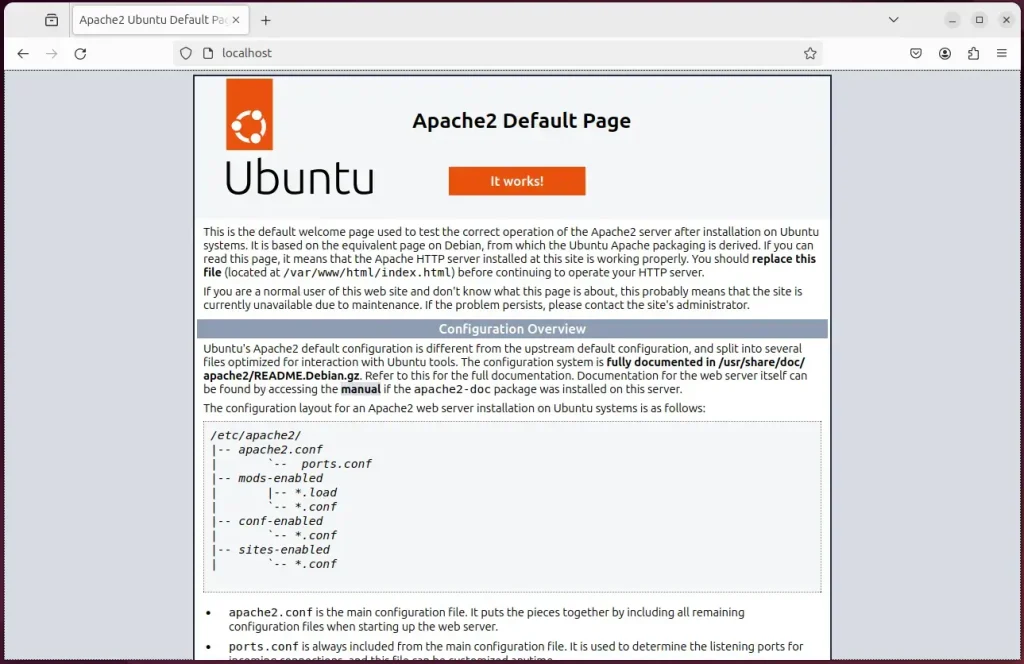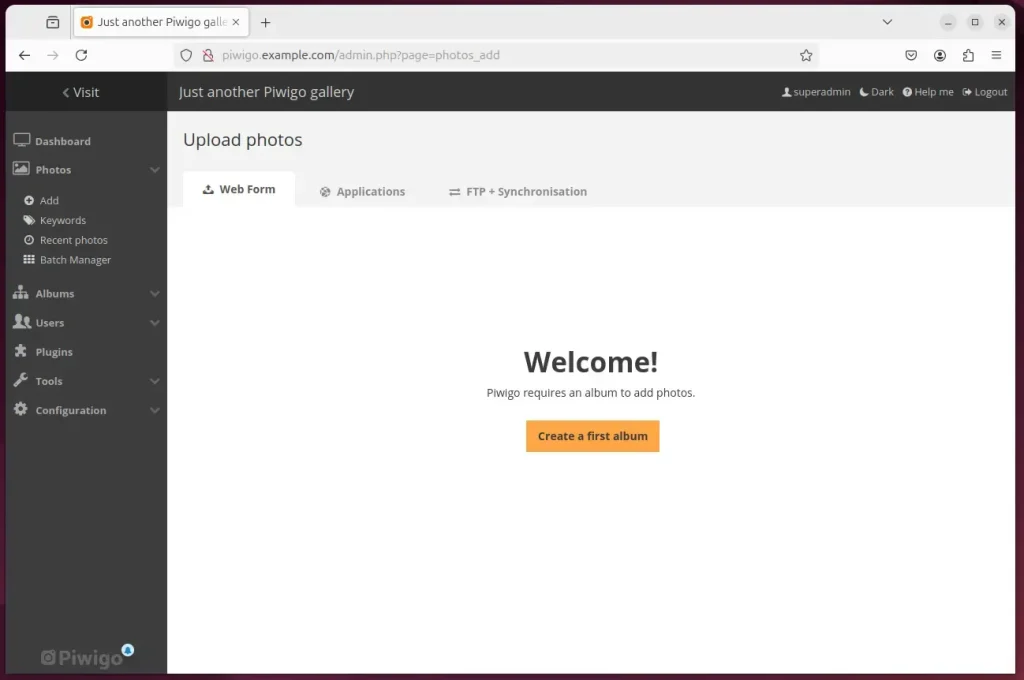This article explains how to install Piwigo with Apache on Ubuntu 24.04.
Piwigo is an open-source, web-based photo gallery software designed to help users organize, manage, and share photo collections online. It offers tools for categorizing images, adding metadata, and customizing galleries via themes and plugins.
The Ubuntu/Apache stack provides a balanced mix of security, scalability, and ease of use for Piwigo, backed by strong community support. It’s ideal for users seeking a self-hosted, cost-effective gallery solution without compromising on features.
Install Apache HTTP server on Ubuntu
Piwigo requires a web server. This post will install and use the Apache web server to run Piwigo.
To do that, open the Ubuntu terminal and run the commands below to install the Apache web server.
sudo apt update
sudo apt install apache2
Once Apache is installed, the commands below can start, stop, and enable the Apache web server to start automatically when your server boots up.
sudo systemctl stop apache2
sudo systemctl start apache2
sudo systemctl enable apache2
You can test the Apache web server by opening your web browser and browsing to the server’s localhost or IP address.
http://localhost

When you see the Apache2 Default Page, it means the Apache HTTP server is successfully installed.
Additional help on installing Apache on Ubuntu is in the link below.
How to install Apache on Ubuntu
Install the MariaDB database server on Ubuntu
The next component required to run Piwigo is a database server. This post will install and use the MariaDB database server.
To install and use the MariaDB database server, use the instructions below.
Open the Ubuntu terminal and run the commands below to install the MariaDB database server.
sudo apt update sudo apt install mariadb-server
Once the MariaDB database server is installed, use the commands below to stop, start, and enable the MariaDB server to start automatically when the server boots.
sudo systemctl stop mariadb sudo systemctl start mariadb sudo systemctl enable mariadb
Run the following commands to validate and test if the MariaDB database server is installed successfully.
sudo mariadb
Once you run the commands above, it will log you onto the MariaDB console and display a message similar to the one below.
Welcome to the MariaDB monitor. Commands end with ; or g. Your MariaDB connection id is 32 Server version: 10.11.2-MariaDB-1 Ubuntu 23.04 Copyright (c) 2000, 2018, Oracle, MariaDB Corporation Ab and others. Type 'help;' or 'h' for help. Type 'c' to clear the current input statement. MariaDB [(none)]>
The message tells you that the server is installed successfully.
Additional help on installing MariaDB.
Create a Piwigo database
Upon successfully installing the MariaDB database server, create a blank database on the server specifically for the Piwigo application.
As part of the setup, we will create a piwigodb database and a user account called piwigodbuser.
Finally, we’ll grant the piwigodbuser full access to the piwigodb database.
All the database steps above can be done using the commands below:
But first, log on to the MariaDB database server:
sudo mariadb
Then run the commands below to complete the steps:
CREATE DATABASE piwigodb CHARACTER SET utf8mb4 COLLATE utf8mb4_general_ci;
CREATE USER piwigodbuser@localhost IDENTIFIED BY 'type_your_password_here';
GRANT ALL ON piwigodb.* TO piwigodbuser@localhost WITH GRANT OPTION;
FLUSH PRIVILEGES;
exit
Ensure to replace ‘type_your_password_here ‘with your password.
Install PHP on Ubuntu Linux
The last component you will need to run Piwigo is PHP. The Piwigo application is PHP-based and supports the latest versions of PHP.
Then, run the commands below to install the latest PHP version.
sudo apt install php libapache2-mod-php php-intl php-mysql php-curl php-cli php-zip php-xml php-gd php-common php-mbstring php-xmlrpc php-bcmath php-json php-sqlite3 php-soap php-zip php-ldap php-imap
Additional help on installing PHP
How to install PHP on Ubuntu Linux
Download Piwigo files
Let’s begin downloading and configuring the Piwigo files on Ubuntu Linux.
To always install the latest version, check the download page for Piwigo. Get the download link and download the archived package to your computer. Then, extract it.
First, navigate to the /tmp/ directory and download the Piwigo files. Next, extract the content into the Piwigo folder in the Apache root directory.
The final step is to change the permissions. This will allow the Apache web server to interact safely with the files, ensuring a secure environment for your Piwigo installation.
Next, run the commands below to change Apache root folder permissions so the Piwigo app can function correctly.
cd /tmp
wget https://piwigo.org/download/dlcounter.php?code=latest -O piwigo.zip
sudo unzip piwigo.zip -d /var/www
sudo chown -R www-data:www-data /var/www/piwigo/
Once you have completed all the above steps, continue configuring the Apache web server below to serve the Piwigo content.
Run the commands below to create an Apache virtual host file for Piwigo.
sudo nano /etc/apache2/sites-available/piwigo.conf
Then, copy and paste the content block below into the Apache server block.
<VirtualHost *:80>
ServerName b2evolution.example.com
ServerAlias www.b2evolution.example.com
ServerAdmin [email protected]
DocumentRoot /var/www/b2evolution
<Directory /var/www/b2evolution/>
Options FollowSymlinks
AllowOverride All
Require all granted
</Directory>
ErrorLog ${APACHE_LOG_DIR}/error.log
CustomLog ${APACHE_LOG_DIR}/access.log combined
</VirtualHost>
Save the file.
Then, run the commands below to enable the virtual host and restart the Apache server.
sudo a2ensite piwigo.conf
sudo a2enmod rewrite
sudo systemctl restart apache2
Setup Let’s Encrypt SSL/TLS for Piwigo
You may want to install an SSL/TLS certificate to secure your Piwigo site. Secure your Piwigo installation with HTTPS from Let’s Encrypt.
Please read the post below for additional resources on installing and creating Let’s Encrypt SSL certificates for Apache.
How to set up Let’s Encrypt SSL certificate for Apache on Ubuntu Linux
Once you have restarted the Apache web server, open your browser and browse to the server hostname or IP address defined in the Apache server block.
http://piwigo.example.com
The Piwigo installation wizard should appear.
Type in the database name, password, and admin account. Click the Start installation button when done.

Piwigo should be ready to use.

That should do it!
Conclusion:
In summary, installing Piwigo on Ubuntu with Apache involves several key steps:
- Web Server Setup: Successfully installed and configured Apache to serve the Piwigo application.
- Database Installation: Installed MariaDB and set up a dedicated database for Piwigo.
- PHP Installation: Installed the required PHP packages for the Piwigo application to function smoothly.
- File Download and Permissions: Downloaded the latest Piwigo files, extracted them, and set appropriate permissions for Apache.
- Virtual Host Configuration: Created a virtual host configuration for Piwigo to ensure proper routing of requests.
- SSL/TLS Security: Recommended the installation of an SSL certificate using Let’s Encrypt for secure access to the Piwigo site.
- User-Friendly Setup: Navigated through the Piwigo installation wizard to finalize the setup.
Following these steps, users can establish a fully functional, secure, and self-hosted photo gallery using Piwigo on an Ubuntu server. Enjoy managing and sharing your photo collections!

Leave a Reply